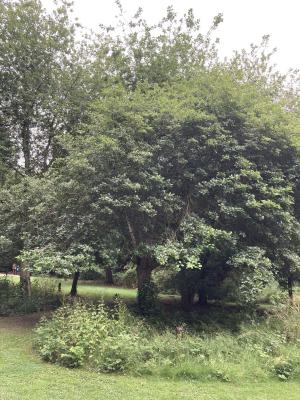Our Tree Collection
It is the soft white hairs on the shoots and leaf-stalks of this tree that give it it's name. It also differs from silver birch in having darker brown twigs and bark that is reddish-brown and missing the black patches characteristic of mature silver birch. The downy birch prefers wetter areas, and is a quick coloniser of poor soils.
The blossoms of wild cherry stand out in snow-white patches in beech woods in the spring. The flowers open in April, before the leaves appear. The leaves have long points and regular teeth, and are borne on red stalks.
Many cherry trees that have been cultivated for their fruit derive from the wild cherry,, whose fruits grow in bunches of three to five, and can taste sweet or bitter. They turn from a yellowish shade to red in July and are a favourite food of the birds. The cherries that survive to later turn blackish.
The tree has a shiny, chestnut-brown bark which peels in horizontal strips. Wild cherry grows rapidly to timber size, and so the wood is often used to make furniture, veneers and pipes. The leaves are alternate, with long points and regular, forward-pointing teeth. The twigs are a grey-brown colour, and the buds brown and shiny and clustered on side-shoots.
The Tibetan Cherry is a small to medium-sized. It is mainly conspicuous because of its very decorative mahogany-coloured bark, which also lead to it being called Mahogany Barked Cherry. Because of its peeling bark it is also called Paperbark Cherry. It blooms in spring with small, white flowers and turns colour beautifully in autumn. It is often grown as a multi-stemmed or short stemmed tree with a wide crown. It will reach 8m (25ft) possibly a little more in ideal conditions.
A shrub or small tree of cliffs and rock outcrops, generally found on hard limestones or other basic rocks, most often in exposed sites but also in less exposed rocky woodland. From near sea level in S. Devon and the Gower to 500 m at Creag Bhuilg in Glen Avon (Banffs.).
A deciduous tree, to around 10m high, with an upright habit and glossy green leaves, coarsely toothed towards the tips and with silvery-grey felted undersides. Flat clusters of white flowers are produced in late spring, followed in autumn by clusters of round, slightly flattened, speckled dark red berries
Clusters of brown nuts, each surrounded by deeply toothed green bracts, identify the common hazel in autumn time. The most distinctive features seen earlier in the year are the long, yellow male catkins, which shed their pollen in February, before the leaves come out.
The small female flowers are contained within the leaf-buds, and are tipped with red stigmas. Slender hazel rods, obtained by coppicing - regular pruning back to ground level - are very pliant and have been used for making many things, from baskets to boats and houses.
The Hawthorn is native to the UK, and the cultivar Crataegus Persimilis Prunifolia has all of its most desirable characteristics. The glossy, dark green oval leaves are complemented in May by clusters of small, fragrant white flowers which cover the tree, attracting bees and butterflies. The leaves turn brilliant shades of red and gold with touches of purple in autumn accented by the bright red berries which will draw birds to the garden into the early winter. The thorny, dense crown provides excellent shelter for birds throughout the year.
Fully hardy in even the most severe climates, this tree can grow to 5 metres high by 4 metres wide in 20 years, reaching a mature height and spread of 8 metres in 50 years. Little or no pruning is required to maintain its natural dome-shaped crown.
This tough native is very hardy and will thrive in a wide variety of growing conditions; full sun or partial shade; in an exposed or sheltered position and in any moist but well-drained soil.





